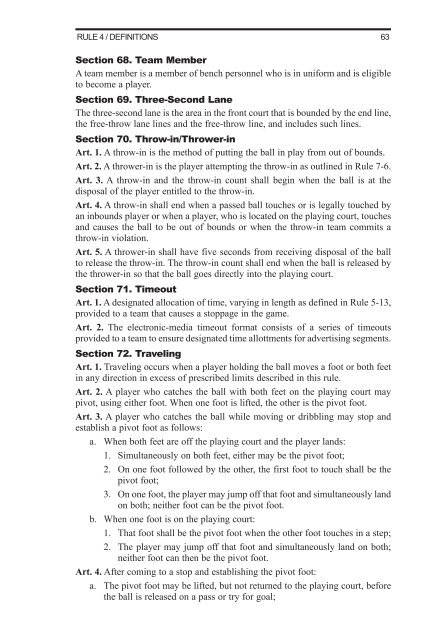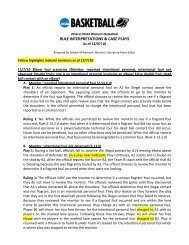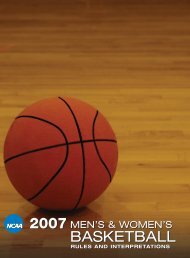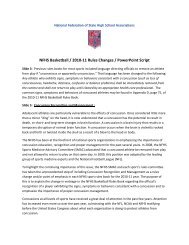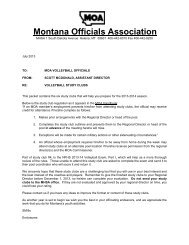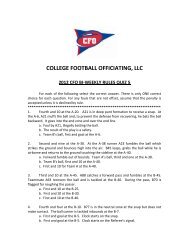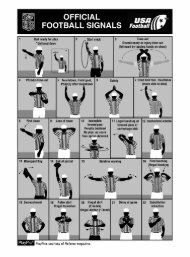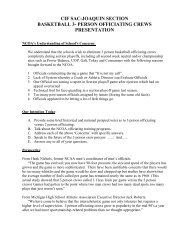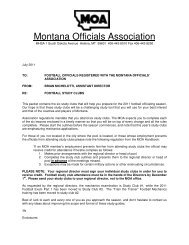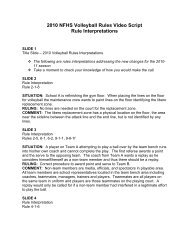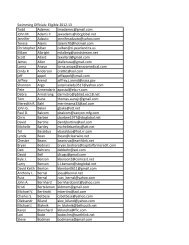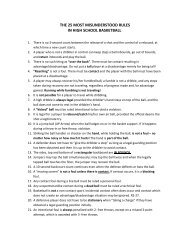2011-12 AND 2012-13 MEN'S AND WOMEN'S RULES - NAIA
2011-12 AND 2012-13 MEN'S AND WOMEN'S RULES - NAIA
2011-12 AND 2012-13 MEN'S AND WOMEN'S RULES - NAIA
You also want an ePaper? Increase the reach of your titles
YUMPU automatically turns print PDFs into web optimized ePapers that Google loves.
RULE 4 / DEFINITIONS63<br />
Section 68. Team Member<br />
A team member is a member of bench personnel who is in uniform and is eligible<br />
to become a player.<br />
Section 69. Three-Second Lane<br />
The three-second lane is the area in the front court that is bounded by the end line,<br />
the free-throw lane lines and the free-throw line, and includes such lines.<br />
Section 70. Throw-in/Thrower-in<br />
Art. 1. A throw-in is the method of putting the ball in play from out of bounds.<br />
Art. 2. A thrower-in is the player attempting the throw-in as outlined in Rule 7-6.<br />
Art. 3. A throw-in and the throw-in count shall begin when the ball is at the<br />
disposal of the player entitled to the throw-in.<br />
Art. 4. A throw-in shall end when a passed ball touches or is legally touched by<br />
an inbounds player or when a player, who is located on the playing court, touches<br />
and causes the ball to be out of bounds or when the throw-in team commits a<br />
throw-in violation.<br />
Art. 5. A thrower-in shall have five seconds from receiving disposal of the ball<br />
to release the throw-in. The throw-in count shall end when the ball is released by<br />
the thrower-in so that the ball goes directly into the playing court.<br />
Section 71. Timeout<br />
Art. 1. A designated allocation of time, varying in length as defined in Rule 5-<strong>13</strong>,<br />
provided to a team that causes a stoppage in the game.<br />
Art. 2. The electronic-media timeout format consists of a series of timeouts<br />
provided to a team to ensure designated time allottments for advertising segments.<br />
Section 72. Traveling<br />
Art. 1. Traveling occurs when a player holding the ball moves a foot or both feet<br />
in any direction in excess of prescribed limits described in this rule.<br />
Art. 2. A player who catches the ball with both feet on the playing court may<br />
pivot, using either foot. When one foot is lifted, the other is the pivot foot.<br />
Art. 3. A player who catches the ball while moving or dribbling may stop and<br />
establish a pivot foot as follows:<br />
a. When both feet are off the playing court and the player lands:<br />
1. Simultaneously on both feet, either may be the pivot foot;<br />
2. On one foot followed by the other, the first foot to touch shall be the<br />
pivot foot;<br />
3. On one foot, the player may jump off that foot and simultaneously land<br />
on both; neither foot can be the pivot foot.<br />
b. When one foot is on the playing court:<br />
1. That foot shall be the pivot foot when the other foot touches in a step;<br />
2. The player may jump off that foot and simultaneously land on both;<br />
neither foot can then be the pivot foot.<br />
Art. 4. After coming to a stop and establishing the pivot foot:<br />
a. The pivot foot may be lifted, but not returned to the playing court, before<br />
the ball is released on a pass or try for goal;


